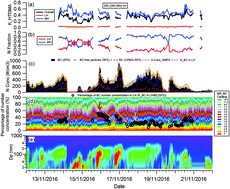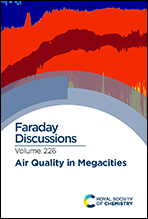Vertical profile of particle hygroscopicity and CCN effectiveness during winter in Beijing: insight into the hygroscopicity transition threshold of black carbon†
Abstract
The hygroscopicity and ability of aerosol particles to act as cloud condensation nuclei (CCN) is important in determining their lifetime and role in aerosol–cloud interactions, thereby influencing cloud formation and climate. Previous studies have used the aerosol hygroscopic properties measured at the ground to evaluate the influence on cloud formation in the atmosphere, which may introduce uncertainty associated with aerosol hygroscopicity variability with altitude. In this study, the CCN behaviour and hygroscopic properties of daily filter collections of PM2.5 from three different heights (8, 120, 260 m) on a tower in Beijing were determined in the laboratory using water, water/methanol and methanol as the atomization solvents. Whilst there was substantial temporal variability in particle concentration and composition, there was little obvious difference in aerosol CCN and hygroscopic behaviour at different heights, although the planetary boundary layer height (PBLH) reduced to below the tower height during the nighttime, suggesting that use of surface hygroscopicity measurements is sufficient for the estimation of aerosol particle activation in clouds. Additionally, the critical coating thickness (in terms of mass ratio of coating/refractory BC, MRc) defining the BC transition between being hydrophobic to hydrophilic, was determined by combining hygroscopic tandem differential mobility analyser (H-TDMA), centrifugal particle mass analyzer (CPMA) and single particle soot photometer (SP2) measurements. The MRc of 250 nm BC-containing particles increased from a background value of between 0.8 and 1.6 to around 4.6 at the onset of the growth event of nanoparticles, decreasing monotonically back to the background level as the event progressed. This indicates that large particles do not act as an effective pre-existing condensation sink of the hygroscopic vapours during the nanoparticle growth events, leading to the 250 nm BC particles requiring more coating materials to transition between being hydrophobic and hydrophilic. These findings show that large particles may be less important in suppressing the new particle formation and subsequent growth in the atmosphere.

- This article is part of the themed collection: Air quality in megacities


 Please wait while we load your content...
Please wait while we load your content...